
~~~~~~~~~~~~~~~~~~~~~~~~~~~~~~~~~~~~~~~~~~~
Live Earth Farm (Com)Post
6th Harvest Week, Season 13
May 12th - 18th, 2008
~~~~~~~~~~~~~~~~~~~~~~~~~~~~~~~~~~~~~~~~~~~
In this issue
--Greetings from Farmer Tom
--What's Up in the Field
--Live Earth Farm Kids
--Clearing up the Fruit Confusion
--Plan Ahead when Picking Up!
--Egg Cartons...
--Pictures around the farm
--What's in the box this week
--Notes from Debbie's Kitchen
--Calendar of Events
--Contact Information
" We know more about the movement of celestial bodies
than about the soil underfoot. "
~ Leonardo da Vinci
Greetings from Farmer Tom
~~~~~~~~~~~~~~~~~~~~~~~~~~~~~~~~~~~~~~~~~~~~~~~~
When schoolchildren visit the farm I like to ask what they think is the most important thing we grow. It's a good way to learn what fruit and veggies they like to eat as well as teach them to distinguish locally grown from imported crops such as the popular bananas, mangoes and pineapples. But my reason for asking the question is not just to focus on what we grow, but also to explore the elements that allow us to grow. I then hint that the most important thing we grow is neither plant nor animal but something we stand on. At first, all I get are puzzled looks, but as they gaze down around their feet, I know the answer is close at hand. Is it "DIRT" Farmer Tom? "That's right, it is dirt – the soil beneath our feet; that which we depend on to grow strong and healthy crops. And for me, as a farmer, it is like ‘money in the piggy bank.’” Call me a "Dirt" Farmer and I won't be offended, I joke with them.
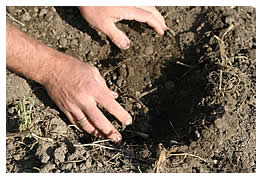 The adults in the group laugh, but then the kids don't want to hear about dirt – they
came to eat strawberries, pet goats, and chase chickens! So I shift gears.
If dirt is going to have any meaning to these kids it has to taste good, so we
venture out into the strawberry field where they are ready to "pounce and
munch". But before I let them loose, I try one more time to get my message
across. I grab a handful of soil and sift it through my fingers, feeling and
smelling it. I explain that a strawberry is only "yummy" and sweet
because it lives in such rich "yucky" soil. Then they are off;
the strawberries are sweet and juicy, staining everything from their lips down,
and I don't hear any complaints if a little dirt is sticking to the fruit and
ending up in their mouths. Harvesting and tasting is as close to a field-to-mouth
experience children can get, and probably a better understanding of the importance
of soil than any explanation Farmer Tom can give.
The adults in the group laugh, but then the kids don't want to hear about dirt – they
came to eat strawberries, pet goats, and chase chickens! So I shift gears.
If dirt is going to have any meaning to these kids it has to taste good, so we
venture out into the strawberry field where they are ready to "pounce and
munch". But before I let them loose, I try one more time to get my message
across. I grab a handful of soil and sift it through my fingers, feeling and
smelling it. I explain that a strawberry is only "yummy" and sweet
because it lives in such rich "yucky" soil. Then they are off;
the strawberries are sweet and juicy, staining everything from their lips down,
and I don't hear any complaints if a little dirt is sticking to the fruit and
ending up in their mouths. Harvesting and tasting is as close to a field-to-mouth
experience children can get, and probably a better understanding of the importance
of soil than any explanation Farmer Tom can give.Most people grow up unaware of the soil-food connection. Growing up in urban environments surrounded by asphalt, concrete and manicured lawns, dirt is just perceived as a filthy substance that soils us. What people don’t realize is that, just as we need air to breath and water to drink, we need soil to feed ourselves. The increase in the Earth's human population has only been possible due to an increase in agricultural productivity – however such productivity has taken its toll on the world's soils. On average, it takes nature 500 years to build an inch of topsoil, however under modern farming practices it’s estimated that topsoil is being depleted 16-300 times faster than it can be replaced.
Good soil is the central building block in a healthy and sustainable food system. Here on the farm, crop rotation, cover cropping, and composting are the keys to maintaining a healthy soil. We also add amendments such as rock dust and gypsum, and the combination of all these things works to increase the organic matter content of the soil, as well as build it up over the long term. As farmers we need to be ever more vigilant so as not to deplete our soils because of increased pressure to grow more food. [And the pressure is indeed great; our waiting list is now nearly two-thirds the size of our membership, and growing by the day! – Debbie] Over the past 6-7 years we have been buying compost, but with the continued increase in fuel prices we are looking into making our own again. Annually we apply about 300 tons of compost to our fields, and I would like to double that amount.
Soil is at the center of any farming operation's long-term sustainability and, ultimately, fundamental to the health of our crops and our own well-being. The vegetables in your shares are a direct connection to the farm’s soil, so next time you are visiting grab a handful of this precious material and let it sift through your fingers, smell it, and imagine tasting it in the crops that are grown from it.
- Tom
<back to top>
What's Up in the Field
~~~~~~~~~~~~~~~~~~~~~~~~~~~~~~~~~~~~~~~~~~~~~~~~
Oh, who says farming isn't cute?? Last week six more baby goats were born, bringing
the total number of "kids" to nine – and we're still waiting
for two moms to give birth (see pictures of newborns in 'Pictures around the
farm', below). We are expecting a heat wave this week; this should give our warm
weather crops their first growth spurt. Potatoes are starting to grow nicely:
the first field was "hilled" last
week. I would guess that in 4 to 5 weeks we'll harvest the first ones for the
shares. Summer squash is starting to bloom, so it’ll be maybe another two
weeks before we start harvesting them. In the meantime, there’s lots of
weeding and hand thinning of what I would say is a bumper crop of apples.
<back to top>
Live Earth Farm Kids
~~~~~~~~~~~~~~~~~~~~~~~~~~~~~~~~~~~~~~~~~~~~~~~~
This week’s pictures and story are from member Karen Fox, who says, “First
thanks so much for all you do, this has been a great experience, better than
I ever expected. I love getting my box, trying new ways to cook new foods, and
visiting some old familiar veggies from my childhood. My hippy parents grew most
of our veggies and raised chickens and rabbits. I have fond memories of eating
in our garden and I love your improvements...ahhh chard with no EARWIGS! Fava
beans that are sweet and tasty raw?! Just enough of a variety of veggies instead
of an overload of things that my dad thought would not grow and overplanted!
“Second, I had to send you pics of this week’s 'box raid' as I have
named it. As soon as our bag arrives home the kids delve into it to see 'what
did we get from our farm?' Today they were having a late afternoon organic lollipop
from Trader Joe’s, when they raided the bag and pulled out the peas to
eat. They started shelling and eating as fast as they could -- note the abandoned
lollipops stuck to the towel! I was laughing and saying the peas were sweeter
than candy, then my son stuck a stick in a pea to demonstrate...too funny.
“So thanks for the laugh, for the beautiful fresh organic veggies, and
for getting my kids excited about farming!”
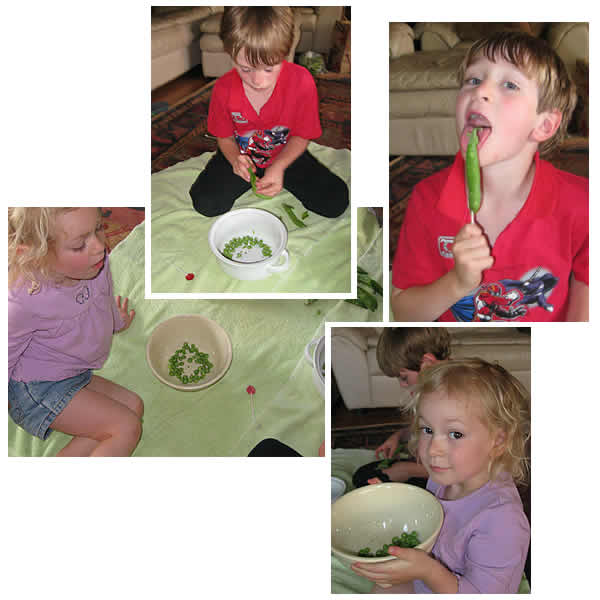
<back to top>
Clearing up the Fruit Confusion
~~~~~~~~~~~~~~~~~~~~~~~~~~~~~~~~~~~~~~~~~~~~~~~~
Hi all, Debbie here. Last week, when the “Extra Fruit” option started,
I got several calls and emails from people saying, ‘I signed up for that “Extra
Fruit Bounty” option but only got 2 baskets while others seem to be getting
more? I was wondering if maybe there was some mistake...'
First of all I want to thank you one and all for only taking the number of baskets
listed next to your name! THANK YOU THANK YOU!! That was the correct thing to
do. The confusion stems from the fact that we have TWO DIFFERENT fruit “options” – “Extra
Fruit” and “Fruit Bounty.” It was only the “Extra Fruit” which
started last week.
Members which I added off our waiting list may not have realized there were two
fruit options, because the “Extra Fruit” sold out early, and so only
the “Bounty” option remained. Confusion is compounded by the fact
that both the Family and Small shares get some fruit as well (Family Share always,
Small Share most of the time but not some weeks).
Anyway, here is the difference between the two fruit options:
Extra Fruit is our original fruit option (we only started the ‘bounty’ option
last year), and it runs for 29 weeks, starting in May, and is every week
until the end of the season in November. The Extra Fruit option is the only option
which gets ALL the different kinds of fruit we grow over the course of the season.
The Fruit Bounty option last year was called the “Strawberry Bounty” option,
because it was only strawberries, and literally tied to when we had a bounty
of them! There are two times per season when we get a definitive ‘flush’ of
strawberries: the first is sometime in May, and a second, slightly smaller one
occurs in September/October. Since we never know exactly which weeks the bounty
will occur (depends on the weather), but we do know approximately when and how
many weeks of it we tend to get, the “Bounty” option is 15 floating
weeks. Tom makes the call as to which weeks we will have the “Bounty” based
on what’s happening in the fields, so you need to keep an eye on the
newsletter for announcements of when it occurs. As you see above, the Bounty
option has started this week!
Now the reason we changed the name to “Fruit Bounty" from “Strawberry
Bounty" is because Tom is growing more kinds and quantities of fruit now, and
so doesn’t
want to limit it to just strawberries. This year’s “Bounty” option
may include other kinds of fruit – it all depends on what we have lots
of!
Anyway, my A-number-one rule still stands: ALWAYS go by the quantity of fruit
listed next to your name on the checklist in the binder at your pickup site.
This is the COMBINED TOTAL of the various kinds of fruit from your Family or
Small shares PLUS any options you have signed up for. My database does the math
and totals like kinds of fruit (this will become clearer when we start having
other kinds of fruit). Please DON’T go by the ‘what’s in the
box’ list
in the newsletter, because that’s only the ANTICIPATED amount of fruit;
it can change at the last minute based on how the harvest comes in, sometimes
as late as the morning of delivery!
If you’re curious about what all fruit we grow and when approximately you
may be seeing it, see the Harvest
Chart on our website.
<back to top>
Plan Ahead when Picking Up!
~~~~~~~~~~~~~~~~~~~~~~~~~~~~~~~~~~~~~~~~~~~~~~~~
Now that strawberry season is upon us, members with fruit options can often be
picking up six or more baskets of berries each week, and this can pose a problem
for some: how to carry all that fruit home with you? You are welcome to take
the strawberry baskets (although we ask that you return them the following week
so we can reuse them), but please don’t take the flat boxes (the yellow
boxes the strawberries are dropped off in). We re-use those as regularly.
Some folks just bring plastic bags and dump their strawberries into them and
leave the baskets. This is fine, but be aware that at times the ripe berries
are more fragile than others and could get smooshed. (You can generally make
this determination when you pick up.)
Another way to go
is to simply bring your own box or tote. Site host Barbie Aknin suggests using “one
of those foil lasagna pans with the plastic top from the store. It lasts all
season and keeps the berries fresh and fits 6 baskets. I put a paper towel at
the bottom to soak up moisture. Folks could keep them [the foil pans] in their
car [like you do with your cloth grocery bags!].”
<back to top>
Egg Cartons...
~~~~~~~~~~~~~~~~~~~~~~~~~~~~~~~~~~~~~~~~~~~~~~~~
Just a quick note on this topic: a few folks were alarmed last week because
some of the cartons of eggs in the coolers at their pickup site were from
other egg companies and so they thought the eggs were too – this
was a false alarm; Jim Dunlop, who raises the pastured chickens from whence
the eggs come says his [egg carton] supplier was short, so he was scrambling
for whatever cartons he could find. I asked him if, when he did this in
the future, he would put a 'TLC Ranch' label on any recycled, non-blank
cartons, so as to assure folks the eggs inside are still from him, and
he was fine with this.
On a related note, this brings up a good reason for returning Jim's half-dozen-sized
cartons to your drop site; our driver
will bring them back to the farm, where Jim can pick them up and re-use
them. He very much appreciates this, and you're doing a good turn by keeping
them out of the waste stream. Remember, reuse is better than recycle!
<back to top>
Pictures around the farm
~~~~~~~~~~~~~~~~~~~~~~~~~~~~~~~~~~~~~~~~~~~~~~~~
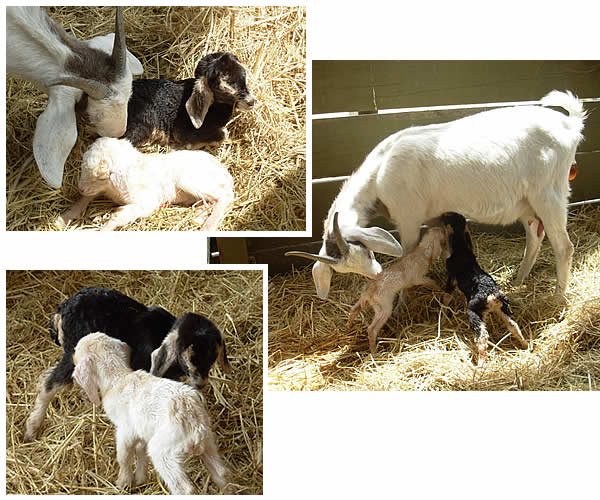
This year's farm intern, Gillian, was on hand when these goats were born,
and snapped some quick pics for us! In image at right, they're so new,
note that they're still trying to figure out which end mom's teats are
at! To give you a sense of size, the babies are about the size of an
average house cat. They grow quickly though!
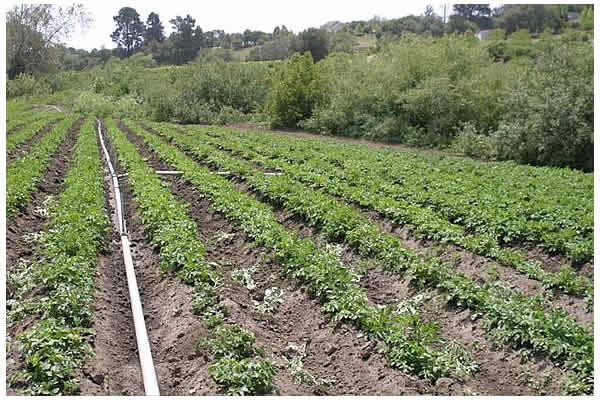
Some of our recently hilled potatotes...
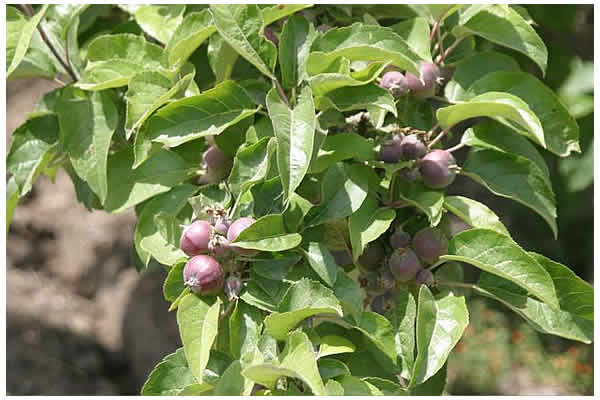 ...
a preview of the bumper crop of apples on this year's trees...
...
a preview of the bumper crop of apples on this year's trees...
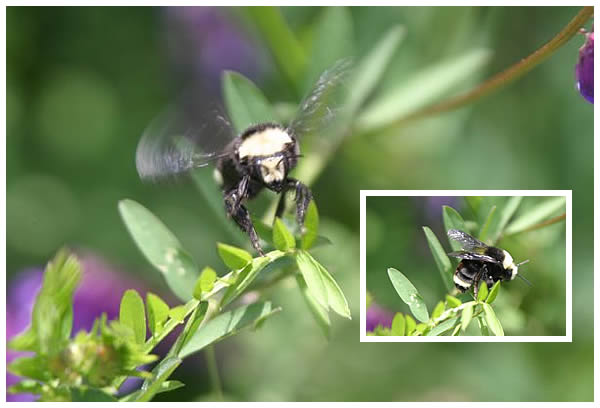
And lastly, Farmer cum Photographer Tom says he just sat down in a field
of flowering vetch (cover crop) which was alive with the humming
of bees... and just waited for them to pose for him!
<back to top>
What's in the box this week
~~~~~~~~~~~~~~~~~~~~~~~~~~~~~~~~~~~~~~~~~~~~~~~~
Content differences between Family and Small
Shares are in red; items
with a “+” in
Family Shares are more in quantity than in Small; anticipated quantities, if
any, are in parentheses, as are the source of any produce if not from Live Earth
Farm (LEF). Occasionally content will differ
from this list (typically we will make a substitution), but we do our best to
give you an accurate projection.
Family Share:
Beets
Broccolini
or broccoli + (if Broccoli, from Lakeside)
Celery (Lakeside)
Chard
Fava
beans +
Garlic (still
green, but starting to mature)
Lettuce +
Bunch of red
mustards or bag of tatsoi
Onions
French breakfast radishes (too small; hopefully next week!)
Scallions
Strawberries (2 or 3 baskets – go by what’s on the list next to your
name in the binder)
Small Share:
Broccolini
or broccoli (if Broccoli, from Lakeside)
Celery (Lakeside)
Collard
greens or Kale
Fava
beans
Garlic (still green, but starting to mature)
Lettuce
Onions
French breakfast radishes (too small; hopefully next week!)
Mystery item (beets or baby carrots)
Strawberries (should be 2 baskets, but as always, go by what’s on the list
next to your name in the binder)
Extra Fruit Option:
Strawberries (should be 3 baskets, but may be more... go by what’s on the
list next to your name in the binder, and read ‘Clearing up the Fruit Confusion’,
above)
Fruit "Bounty" Option!:
Also strawberries (should be 3 baskets, but may be more... go by what’s
on the list next to your name in the binder, and read ‘Clearing up the
Fruit Confusion’,
above)
<back to top>
Notes from Debbie's Kitchen
~~~~~~~~~~~~~~~~~~~~~~~~~~~~~~~~~~~~~~~~~~~~~~~~
Click
here to go to recipe database
This week we’re getting the last of this go-round of beets (the regular
red “Ace”). Tom says he’s clearing the field, and that they’ll
be bunched, instead of topped and bagged like two weeks ago. He’s not quite
sure how much he’ll get when they’re all harvested, so the plan is
to put them into the Family shares, and maybe the Small shares too. If there
aren’t enough for both shares, baby carrots may be substituted in the Small
shares (hence the ‘mystery’ item). The beet greens Tom says are on
the small side, but when you get your beets home, top them for storage, throw
the leaves into a basin of water to rinse/swish away any dirt, then pull out
the good leaves and spin ‘em in a salad spinner and store wrapped in a
cotton towel (or paper towels) in a plastic bag in the fridge. Remember, you
want to store the roots separately from the greens; if you leave the greens attached,
they tend to suck moisture from the root and make it rubbery. But don’t
compost the greens! They’re basically an extra green leafy veggie. Beet
greens can be used in pretty much any recipe you might use chard.
Oh, and by the way, it was a (wonderful!) surprise to also get golden beets mixed
in with our red beets the week before last. Golden beets are delicious and mild
and sweet; if you’re at all on the fence about eating beets, try the golden
beets. You may be pleasantly surprised!
Here’s a beet recipe I’ve been meaning to try next time
we got beets:
Beet Gnocchi with Rosemary
[that’s pronounced “NYO-kee”]
from another Bon Appetit clipping; serves 8 as a first course; 4 as a main course
3 small beets, trimmed
1 lb. fresh ricotta cheese
1 large egg
¾ C freshly grated Parmesan cheese
1 ¼ tsp salt
¼ tsp freshly ground black pepper
1 ½ C flour, divided
½ C (one stick) unsalted butter
8 3-inch long fresh rosemary sprigs
Additional freshly grated Parmesan cheese for serving
Preheat oven to 450 degrees F. Wrap beets in foil and roast until tender, about
1 hour. [Note from Debbie: because we tend to keep our beets in the fridge, this
adds to their baking time. If you think of it, take ‘em out so they can
come to room temperature first. They may cook a little quicker. Of course I always
forget to do this, but I thought if I wrote it down I might remember!] [Beets
are done when they pierce easily with the tip of a sharp knife.]
Allow beets to cool enough to handle, then slip off skins; discard [compost]
skins.
Coarsely grate beets. Place ¾ C grated beets in large bowl (reserving
any remaining beets for another use [i.e. in one of those ‘beet sandwiches’ from
last week!]. Stir in ricotta, egg, and ¾ C parmesan cheese, salt and pepper.
Mix in 1 C of the flour.
Lightly dust baking sheet with flour. Place remaining ½ C flour in a small
bowl. Using a tablespoon measure as an aid, scoop dough into rounds; transfer
to bowl with flour. Coat rounds with flour, then roll each into little oblong
footballs in the palms of your hands. Hold each gnocchi in the palm of one hand
and gently press centers with fingertips to make slight indentations [the better
to hold sauce or butter with!!]. Transfer gnocchi to prepared baking sheet.
Melt butter with rosemary sprigs in heavy large skillet over medium heat. Cook
until butter begins to brown, about 3 minutes. Set aside.
Working in batches, cook gnocchi in a large pot of simmering salted water until
gnocchi float to the surface, about 2 minutes. Continue to cook 1 ½ minutes
longer. Using a slotted spoon, transfer gnocchi to skillet with butter and rosemary.
Heat butter and gnocchi over medium heat, stirring gently to coat. Transfer to
plate; sprinkle generously with additional Parmesan cheese and serve.
Looks like the only ‘new’ veggie in this weeks’ shares is the Collard
greens in the Small shares (and of course the celery from Lakeside, but I
think everybody is familiar with that!). Collard greens look to me like Chinese
paper fans: the leaves are more-or-less round and flat; a kind of dusty-dark
green with light green stems and veins. Collards are a stronger-flavored green
and so can benefit from longer, slower cooking in soups or braises. But the weather’s
getting hot, so I think I might try inverting my ‘hot salad’ idea;
that is, take a green that you’d normally cook and eat hot, and go ahead
and cook it (strip leaves from stems then boil in well salted water for 5 to
7 minutes), but then chill it and serve it with a vinaigrette or lemony sauce
of some sort! Or maybe with a hot sauce tucked into a tortilla with some cheese
and/or beans...
Actually in light of the arriving heat, I’d recommend treating the broccoli similarly.
It doesn’t need to be cooked
that long; just steam it for 3 to 5 minutes, until just tender, then chill. Dress
with lemon and olive oil and salt (or your favorite salad dressing) just before
serving, as the beautiful green broccoli color turns a sort of olive after awhile
in an acid dressing. Put another way, chill it then dress it, don’t dress
it then chill it!
Favas in the Raw
Before I forget (Karen Fox’s story above reminded me!), I, too, learned
just last week that fresh fava beans can actually be eaten raw! Remove
the pods, peel off the skins, and pop ‘em in your mouth like a snack! My
friend had some growing in his backyard, and he says he does this all the time.
I tried it and they were good!
Alert: please read about raw favas
From my archives of submitted recipes, here’s one sent by member Christie
Boone to the LEFCSAfriend
yahoo group (of which, by the way, you’re welcome
to join!):
Fava Beans with Yogurt, Lemon, and Dill
from Deborah Madison's "Vegetarian Cooking for Everyone"
4 lbs. fresh fava beans in their pods
2 1/2 tbsp. extra virgin olive oil
3 scallions, including some of greens, thinly sliced [or you can use the light
green stems of the big onions]
1 tsp. finely grated lemon zest
1 tbsp. fresh lemon juice
Salt and pepper
3 tbsp. finely chopped dill [Christie says she uses dried dill to taste]
1/3 C yogurt, whisked until smooth (unnecessary if have runny yogurt to start)
Shell the favas and peel them if they're large. Cook them in a medium skillet
over medium heat in 1 tablespoon of olive oil until they're tender, about 10
minutes, then stir in scallions and turn off the heat. (NOTE from Christie: I've
been shelling the beans, blanching for 1 minute in boiling water, skinning them,
and then since they're basically cooked already, just heating them up again briefly
in the olive oil instead of cooking for 10 minutes.) [That’s what I’d
do too, Christie! – Debbie] Whisk together the remaining oil, lemon zest,
juice, and a pinch of salt. Pour it over the beans, add most of the dill, and
gently mix everything together. Season with pepper. Pile the beans in a dish,
drizzle the yogurt over all, and garnish with the remaining dill. Serve warm
or chilled.
Christie says, “I've found this dish to be great warm or cold, and extremely
forgiving in terms of ingredient portions. I also just mix everything together
rather than drizzling the yogurt at the end. It's very good, and very easy!”
And another fava recipe, this one from member Holly Trapp:
Persian Sabzi Polo (Herbed Rice with Fava Beans)
6 C water
4 C uncooked Basmati rice
3 tbsp. vegetable oil
1 bunch fresh dill, chopped
1 bunch fresh parsley, chopped
1 bunch fresh cilantro, chopped
2 C fava beans (shelled, cooked and skinned)
ground turmeric to taste
ground cinnamon to taste
1 tsp. salt
1 tsp. pepper
In a large saucepan bring water to a boil. Rinse rice; stir into boiling water.
Reduce heat and simmer for 5 minutes. Stir in dill, parsley, cilantro, fava beans,
turmeric, cinnamon, salt and pepper. Cover and simmer on lowest heat for 40 to
45 minutes. Note: It's normal to end up with crispy rice (called Tadig) on the
bottom of the pot after cooking; it's delicious.
<back to top>
2008 Calendar of Events
~~~~~~~~~~~~~~~~~~~~~~~~~~~
For details on events listed
below, please Click
here to go to the calendar page on our website.
Santa Cruz Permaculture Design course - one weekend/month for
6 months, Feb-July
Spring "Six Thursdays" Mataganza Garden Internship - every
Thursday from May 1st through June 5th, 10am - 5pm, in the Mataganza
Garden Sanctuary at Live Earth Farm.
Herbalism Classes at Live Earth Farm:
<>Herbal First Aid - March 15-16
<>Medicine Making - May 10-11
<> Cooking with Herbs - July 19-20
Summer Solstice Celebration - Saturday June 21st
Children's Mini-Camp - July 11th - 13th (Friday evening thorugh Sunday
noon)
Fall Equinox Cob Building Workshop and Campout - Sept. 20 and 21
Fine Farm Feast - Oct 4th
Fall Harvest Celebration - later in October (date TBA)
Contact Information
~~~~~~~~~~~~~~~~~~~~~~~~~~~
email Debbie at the farm (for any farm or CSA share-related business): farmers@cruzio.com
email Debbie at home (with newsletter input or recipes): deb@writerguy.com
farm phone: 831.763.2448
website: http://www.liveearthfarm.net
~~~~~~~~~~~~~~~~~~~~~~~~~~~